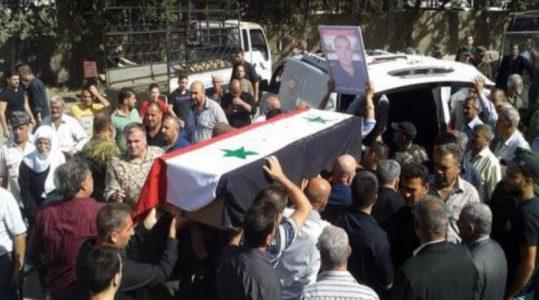
ISIS execution of Druze woman enrages the community
In a gruesome video posted on social media, two ISIS fighters, their faces covered, prepare to shoot a 25-year-old woman in the back of the head as she kneels in front of them. The camera pans away to a blank wall as the shots are heard, a few seconds after one of the men ends his speech.
“If the campaign against our brothers in the region of Al Safa doesn’t end, and our Muslim brothers are not freed from prison in the next three days”, he shouts, then the rest of the hostages will know “the same fate as this apostate Druze woman”.
Tharwat Abu Ammar was captured on July 25, along with 29 other people from her village in the predominantly Druze region of Sweida in Southern Syria. Nearly 250 people died during the attacks led by ISIS that day.
Her October 1 execution follows the beheading of the only male member of the group in early August. Muhannad Toukan Abu Ammar, a 19-year-old engineering student, had been captured with his mother. Like many other religious minorities, the Druze, an ancient offshoot of Islam, are vilified by ISIS.
These past few weeks, the Syrian army has launched a major offensive against the extremist group in the region, particularly around the volcanic and barren area of Al Safa, east of Sweida. But the hostages are believed to be held in the town of Hajin, one of ISIS’ last pockets near the Iraqi border, Nour Radwan, the head of local news website Sweida 24, told The National.
Pictures of Tharwat’s body, covered in blood, have widely circulated on social media, angering locals in Sweida, who are still reeling from the shock of the July attacks. Yesterday, people took to the streets, firing live bullets in the air.
On the same day, a committee headed by religious Druze figures that had been set up to negotiate the hostages’ releases resigned, apologising for having failed in its mission. In a press release, it accused the “terrorists” of not making their demands clear.
“The committee resigned one hour before the video of the (latest) execution was sent out in order to avoid taking responsibility”, argued Mr Radwan.
Locals continued voicing their anger on Wednesday, fearing that ISIS will follow up on its pledge of executing the rest its captives in the next few days. Sweida 24 published a video showing a woman screaming in front of the Sweida governorate’s building as protesters blocked its entrance.
“There is great tension in the streets”, local resident, Kinan Al Yassin, wrote in an email to The National. “Small groups of people are blocking roads”.
The climate of distrust and fear has been enhanced by the recent release of Bedouin women captured by local militias as a “gesture of good will”, adds Mr Al Yassin. Their husbands were suspected of collaborating with ISIS. However, Mr Radwan argues the Bedouin women were “innocent”.
Some think that the Druze community is being punished for staying neutral in the Syrian conflict and not sending its young men to the army. Military conscription is obligatory for all Syrian men between the age of 18 and 42 across the country.
In a detailed report published early September, The Daily Beast quoted a Druze leader as saying: “We think there is complicity between Daesh and the regime” in Damascus, using an Arabic acronym for ISIS.
“Some activists believe what is happening in Sweida has been orchestrated to force young people to serve in the army”, Mr Radwan said. “But there is no proof of this on the ground”.
The fate of the remaining women and children in captivity looks grim.
“I don’t think Daesh is interested in negotiating”, said Mr Al Yassin. “They just want to create dissent between the Druze and the Bedouins in order to embarrass the Russians”, who are allied with the Syrian regime and are negotiating to release the hostages.
“I think these provocative executions will continue”.
Source: The National





